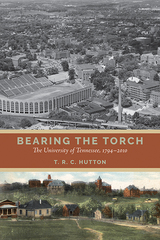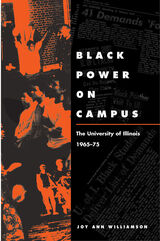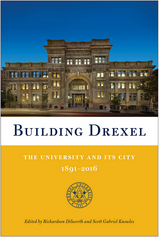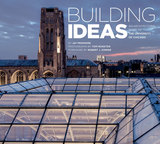8 start with B start with B

Bearing the Torch stands as a comprehensive history of the University of Tennessee, replete with anecdotes and vignettes of interest to anyone interested in UT, from the administrators and chancellors to students and alums, and even to the Vols fans whose familiarity with the school comes mainly from the sports page. It is also a biography of a school whose history reflects that of its state and its nation. The institution that began as Blount College in 1794 in a frontier village called Knoxville exemplifies the relationship between education and American history.
This is the first scholarly history of UT since 1984. T. R. C. Hutton not only provides a much-needed update, but also seeks to present a social history of the university, fully integrating historical context and showing how the volume’s central “character”—the university itself—reflects historical themes and concerns. For example, Hutton shows how the school’s development was hampered in the early nineteenth century by stingy state funding (a theme that also appears in subsequent decades) and Jacksonian fears that publicly funded higher education equaled elite privilege. The institution nearly disappeared as the Civil War raged in a divided region, but then it flourished thanks to policies that never could have happened without the war. In the twentieth century, students embraced dramatic social changes as the university wrestled with race, gender, and other important issues. In the Cold War era, UT became a successful research institution and entered into a deep partnership with Oak Ridge National Laboratories that persists to this day. All the while UT athletics experienced the highs of national championships and the lows of lawsuits and losing seasons. UT is a university with a universe of historical experiences.
The University of Tennessee’s story has always been defined by inclusion and exclusion, and the school has triumphed when it practiced the former and failed when it took part in the latter. Bearing the Torch traces that ongoing process, richly detailing the University’s contributions to what one president, Joseph Estabrook, called the “diffusion of knowledge among the people.”

Benjamin Franklin - American Writers 19 was first published in 1962. Minnesota Archive Editions uses digital technology to make long-unavailable books once again accessible, and are published unaltered from the original University of Minnesota Press editions.

This guide contains 1,400 reviews of the best children's literature published between 1966 and 1972.


This volume carries on the tradition established by Zena Sutherland's two earlier collections covering the periods from 1966 to 1972 and 1973 to 1978. Her 1973 edition of The Best in Children's Books was cited by the American School Board Journal as one of the outstanding books of the year in education.

Drawing on student publications of the late 1960s and early 1970s, as well as interviews with student activists, former administrators, and faculty, Williamson discusses the emergence of Black Power ideology, what constituted "blackness," and notions of self-advancement versus racial solidarity. Promoting an understanding of the role of black youth in protest movements, Black Power on Campus is an important contribution to the literature on African American liberation movements and the reform of American higher education.

Published in conjunction with Drexel University’s 125th anniversary, Building Drexel chronicles the founding of the university by Anthony J. Drexel through to the present day. The editors and contributors create a prismatic discussion of the university and its evolution.
Richly illustrated chapters cover the architectural history of notable Drexel buildings; the role of Drexel in Philadelphia’s modern history; its Greek life; sports—particularly Drexel’s history in the Big 5; and each of the university’s schools and colleges. There is a history of the medical college and law school, plus the creation of new schools such as those of biomedical engineering, science and health systems.
Building Drexel also documents the civil rights history of Drexel and its urban planning history in relation to the racially diverse Powelton Village and Mantua neighborhoods it borders. This commemorative volume shows the development of the university both in the city and in the world.
Contributors include: Lloyd Ackert, Cordelia Frances Biddle, Paula Marantz Cohen, Donna Marie De Carolis, Roger Dennis, Gloria Donnelly, Kevin D. Egan, Alissa Falcone, David Fenske, John A. Fry, Stephen F. Gambescia, Marla J. Gold, Charles Haas, Kathy Harvatt, Daniel Johnson, Jeannine Keefer, Larry Keiser, Michael Kelley, Jason Ludwig, Jonson Miller, Julie Mostov, Danuta A. Nitecki, Anthony M. Noce, Steven J. Peitzman, David Raizman, Tiago Saraiva, Amy E. Slaton, Nathaniel Stanton, Virginia Theerman, Laura Valenti, James Wolfinger, Eric A. Zillmer, and the editors.

Building Ideas: An Architectural Guide to the University of Chicago explores the environment that has supported more than a century of exceptional thinkers. This photographic guide traces the evolution of campus architecture from the university’s founding in 1890 to its plans for the twenty-first century.
When William Rainey Harper, the university’s first president, and the trustees decided to build a set of Gothic quadrangles, they created a visual link to European precursors and made a bold statement about the future of higher education in the United States. Since then the university has regularly commissioned forward-thinking architects to design buildings that expand—or explode—traditional ideals while redefining the contemporary campus.
Full of panoramic photographs and exquisite details, Building Ideas features the work of architects such as Frank Lloyd Wright, Henry Ives Cobb, Holabird & Roche, Eero Saarinen, Ludwig Mies van der Rohe, Walter Netsch, Ricardo Legorreta, Rafael Viñoly, César Pelli, Helmut Jahn, and Tod Williams Billie Tsien Architects. The guide also includes guest commentaries by prominent architects and other notable public figures. It is the perfect collection for Chicago alumni and students, Hyde Park residents and visitors, and anyone inspired by the institutional ideas and aspirations of architecture.
READERS
Browse our collection.
PUBLISHERS
See BiblioVault's publisher services.
STUDENT SERVICES
Files for college accessibility offices.
UChicago Accessibility Resources
home | accessibility | search | about | contact us
BiblioVault ® 2001 - 2024
The University of Chicago Press









